A4M – Additive for Mobility: the Austrian lighthouse project for the mobility sector


In the end of September, the new FFG-funded lighthouse project, “Additive for Mobility” (A4M), aimed at revolutionising the mobility sector through innovative additive manufacturing technologies, was kicked-off!
In today’s dynamic market, the mobility transition is crucial for a sustainable future, as mobility relies heavily on fossil resources for the use of vehicles, airplanes, ships and trains. In order to reduce the associated greenhouse gas emissions, various alternative technologies are currently being developed for future-oriented mobility.
In the next four years, the consortium of A4M will be working on developing a novel additive process chain, providing new opportunities for flexible, resilient, and sustainable serial production of essential components across automotive, aerospace, and railway industries.
Led by the Institute for Production Engineering and Photonic Technologies of TU Wien, this lighthouse project brings together industry leaders from all over Austria: Technische Universität Wien Institut für Fertigungstechnik und Photonische Technologien, BMW Motoren GmbH, EIT Manufacturing East GmbH, Fill Gesellschaft m.b.H., Fraunhofer-Institut für Gießerei-, Composite- und Verarbeitungstechnik IGCV, Friedrich Deutsch Metallwerk Gesellschaft m.b.H., Global Hydro Energy GmbH, igm Robotersysteme AG, MAGNA Metalforming GmbH, ModuleWorks GmbH, RECENDT – Research Center for Non-Destructive Testing GmbH, Rechenraum GmbH, RHP-Technology GmbH, SBI GmbH, TEST-FUCHS Aerospace Systems GmbH, Technische Universität Wien Institut für Werkstoffwissenschaft und Werkstofftechnologie, and voestalpine Giesserei Linz GmbH.
The project was kicked-off in the end of September at the TEC-Lab Laboratory for Production Engineering of TU Wien, gathering all project partners for the first time.
The aim of the project A4M is to develop a flexible and resilient manufacturing system consisting of novel additive technologies of 3D sand printing (used for complex castings) and wire-based additive manufacturing (e.g. Wire Arc Additive Manufacturing, WAAM). If additive technologies are considered separately and detached from conventional manufacturing methods, various technical and economic limitations prevent further industrialisation of these promising technologies in the industry. By integrating their strengths, a new type of manufacturing system can be created that best supports the current requirements of the global mobility transition.
We are looking forward to a great collaboration with all project partners and are looking forward to the results that will come out of this project.
A4M – Additive for Mobility
Read more about the Austrian lighthouse project A4M

